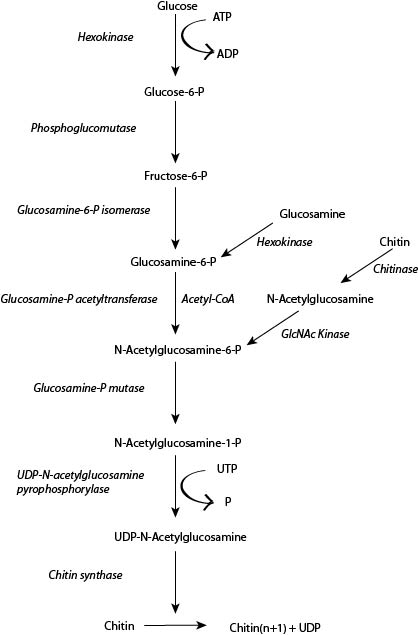|
Chitin is an abundant biopolymer found primarily in the exoskeletons of arthropods, including many insects and crustaceans. Composed of N-acetylglucosamine monomers (Figure 1), it functions analogously to keratin in mammalian skin, providing a support matrix for the protective outer surface of these animals. Similarly, most fungi produce chitin in their cell walls for structural support. Chitin production in Saccharomyces cerevisiae depends on a series of enzymatic steps (Figure 2). Figure 1 Chitin molecular structure.
Source: [http://en.wikipedia.org/wiki/Chitin Wikipedia - Chitin]
One enzyme in this pathway, chitin synthase 3 (CHS3), was previously found to be among the most active chitin sythases in the chitin synthase family of enzymes and does not require additional cofactors to function. As a result, we use CHS3 as the chitin production mechanism in our inducible system ([http://partsregistry.org/Part:BBa_K418007 BBa_K418007]).  Figure 2 Chitin synthesis pathway.
Adapted from Figure 3.1 of Chitin: Fulfilling a Biomaterials Promise by Eugene Khor.
Chitin has many applications, particularly in medicine and industry. Currently, nearly all chitin is obtained from natural sources (i.e. shells of crustaceans). Thus, a method of recombinant chitin production may have commercial applications. Several examples of chitin usage are listed below:
SIGNIFICANCE OF CHITIN:
Medicinal Use:
- Wound and burn treatment/healing
- Hemostasis for orthopedic treatment of broken bones
- Viscoelastic solutions for ophthamology and orthopedic surgery
- Abdominal adhesion treatment
- Antibacterial and antifungal agents
- Tumor therapies
- Microsurgery and neurosurgery
- Treatment of chronic wounds, ulcers and bleeding (chitin powder)
Industrial Use:
- Food/Pharmaceutical/Agricultural/Cosmetic thickener, stabilizer
- Agricultural protection
- Water resistant properties
- Dietary supplement
- Water purification
- Edible microcrystalline films used to preserve food
- Sequestering of particles (i.e. oil)
- Biodegradable/non-pollutant
|